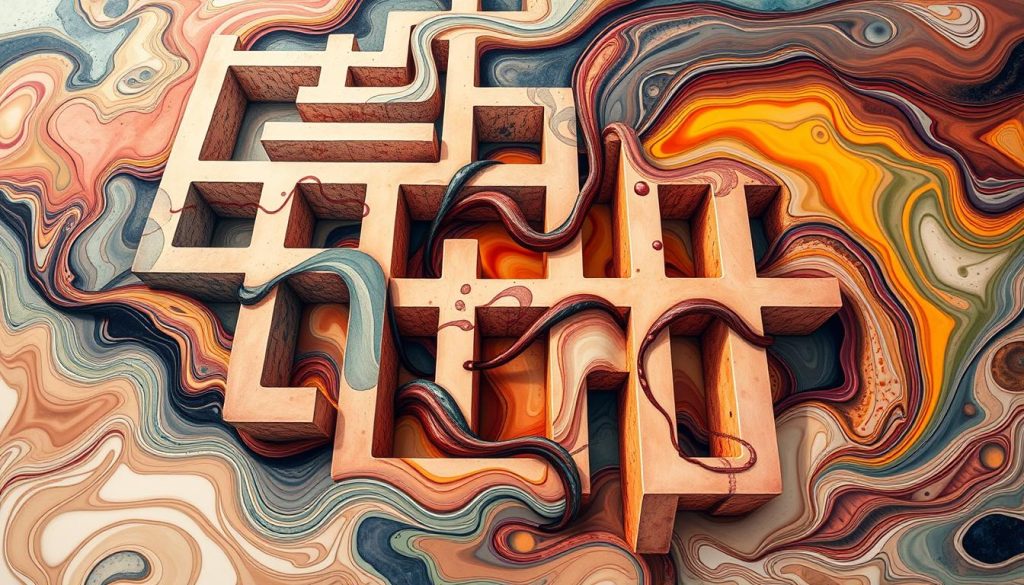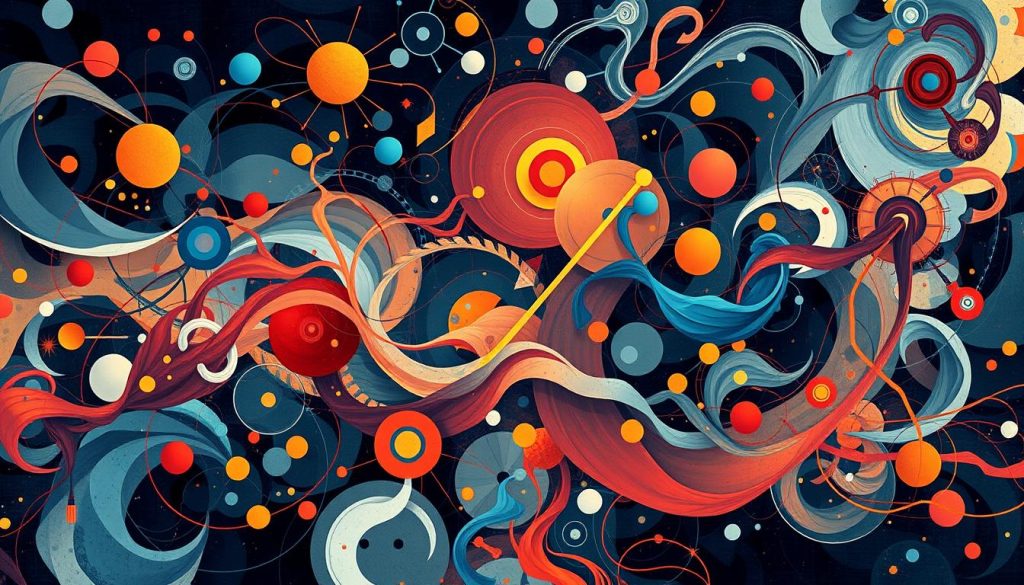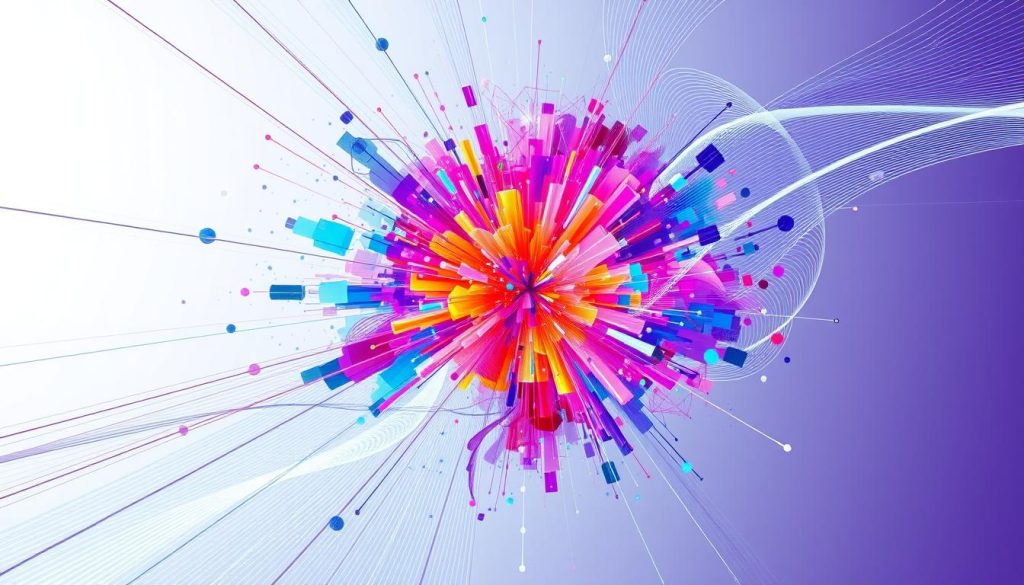Art has a new frontier where tech meets creativity. Welcome to generative art, where algorithms and AI meet artist’s dreams. We’ll explore how AI and machine learning change art and what’s possible in digital art.
We’ll look at the history and growth of generative art. We’ll see how algorithms and machine learning help artists. They make art that challenges what we think art should be.
Generative art uses many techniques. Artists use genetic algorithms and neural networks to make art that changes and grows. Let’s see how tech and creativity come together. Code and algorithms create art that’s limitless.
What is Generative Art?

Generative art is a cool way to mix tech, algorithms, and art. It uses computer programs and algorithms to make art. These systems make unique art based on rules set by the artist.
Understanding the Concept
Generative art is also known as algorithmic, computational, or procedural art. It’s a changing art form. It lets artists give up some control to computers or algorithms.
The Role of Algorithms
- Algorithms are key in generative art. They help shape the art-making process.
- These algorithms explore patterns, randomness, and new behaviors. This leads to unique and surprising art.
- Artists set the rules for the system. But the final art is always a surprise, full of unexpected moments.
“Generative art is the art of creating art, using autonomous systems as their creative engine.” – Philip Galanter, artist and theorist
Technology, algorithms, and creativity have opened up new ways to make art. This field is always changing and exciting. It inspires artists, programmers, and art lovers.
The Evolution of Generative Art
The story of generative art is fascinating. It tells of artists who mixed technology with creativity. Since the mid-20th century, pioneers like Herbert W. Franke, Manfred Mohr, and Vera Molnar have led the way. They set the stage for this exciting art form.
Early Pioneers and Experiments
Generative art’s early leaders were bold. They saw how computer programming and algorithms could open new doors in art. Their work mixed code, math, and beauty in new ways.
- Herbert W. Franke, a German artist and physicist, was a pioneer. He started making generative art in the 1950s.
- Manfred Mohr, a French artist, is a big name in generative art. His work from the 1960s is still important today.
- Vera Molnar, a Hungarian-French artist, was a key figure. She used computers in art and explored randomness and math in her work.
These early works set the stage for generative art’s growth. They inspired later artists to explore tech and creativity together.
“Generative art is not just a tool, but a way of thinking about art that embraces the unpredictable and embraces the unknown.” – Manfred Mohr
AI and Machine Learning in Generative Art

AI and machine learning have changed generative art a lot. These new technologies let artists be more creative. They make complex and beautiful art that would be hard or impossible to make by hand.
AI uses special algorithms and neural networks to help artists. This lets them make unique and surprising art. AI in generative art has opened new doors. Artists can try new things and make art that mixes human and machine.
Machine learning is key in this change. It lets artists train algorithms with lots of art data. This way, they can make new art that’s original but still inspired by traditional styles.
“AI and machine learning have given us the ability to create generative art that is truly unique and visually captivating. It’s a profound shift in the way we think about art and creativity.”
AI and digital art together have opened new doors for artists. They can explore new ways to express themselves. From making landscapes to abstract art, AI’s impact on generative art is clear.
As AI and machine learning get better, we can’t wait to see what generative art will do next. The future of combining technology and creativity is exciting. We’re looking forward to seeing new and interesting art soon.
Generative Art: Merging Technology and Creativity

Generative art brings together tech and art in a cool way. Artists use code and algorithms to explore new creative spaces. This mix of tech and art lets them express themselves in new ways.
Artistic Expression Through Code
Generative art is where tech meets creativity. Artists write code and set rules for algorithms. This lets them make art that changes and grows, going beyond old ways of making art.
Creating generative art is like a dance. The artist sets the rules and the machine makes it come alive. This mix lets artists express themselves in a way that’s both planned and surprising.
“Generative art is the ultimate expression of the human-machine collaboration, where the artist’s vision and the algorithm’s potential collide to create something truly remarkable.”
Generative artists use code and algorithms to push art to new heights. This mix of tech and art opens up new ways to be creative. It inspires artists to see what’s possible with tech.
Exploring Different Generative Art Techniques
Generative art uses many techniques to make art, sound, or interactive pieces. Genetic algorithms and evolutionary art are interesting. So are neural networks and deep learning.
Genetic Algorithms and Evolutionary Art
These methods use an ongoing process. They mix and change parts of an artwork to make new ones. This lets artists explore many ideas and find unique art.
It’s like natural selection in art. Artists use evolution to find new ways to see things.
Neural Networks and Deep Learning
Neural networks and deep learning use artificial intelligence. They make complex patterns and art. This art looks amazing and seems smart.
As technology gets better, so does the art. We’ll see more new and exciting art.
Generative art is always changing and exciting. It mixes technology and creativity. Artists are always finding new ways to make art.
“Generative art is a field where the artist creates a set of rules or an algorithm, and then lets the computer execute those rules to create the final artwork. The resulting pieces are often unpredictable and unique, showcasing the power of technology to unlock new avenues for artistic expression.”
Generative Art in Action
In the world of generative art, we see many inspiring examples and new uses. From beautiful patterns made by algorithms to interactive displays, this field is changing creativity and tech.
Exploring Generative Art Applications
Generative art is used in many places, showing its wide reach and effect. Artists like Manfred Mohr make stunning art with code. The teamLab collective creates interactive art that mixes the digital and real worlds, letting people help shape the art.
It’s not just for art. Generative art also goes into data visualization, product design, and architecture. It lets us make unique and changing art from data or algorithms. This opens new ways for companies to make engaging and personal experiences.
“Generative art is not just a tool for artistic expression; it’s a bridge between the digital and physical worlds, allowing us to reimagine how we interact with and experience our surroundings.”
Looking into generative art applications and generative art use cases, we see endless creative possibilities. Technology and human creativity come together to make new things possible.
From amazing digital art to immersive experiences, examples of generative art show its endless imagination and innovation. As we keep exploring and using generative art, we’ll see more amazing uses and applications. This will change how we see and interact with the world.
The Future of Generative Art
Technology is always changing, and so is generative art. With new tech like quantum computing, blockchain, and virtual/augmented reality, we see endless possibilities. This mix of tech, creativity, and imagination is set to change the game.
Emerging Trends and Possibilities
Artists are now exploring new areas and mixing different techniques. They’re pushing the limits of what generative art can do. We’re looking at big changes, like using quantum computing and combining the physical and digital worlds.
Blockchain could change how we share and sell generative art. It makes transactions safe and lets artists keep control of their work. Virtual and augmented reality will also change how we experience art, making it more immersive.







